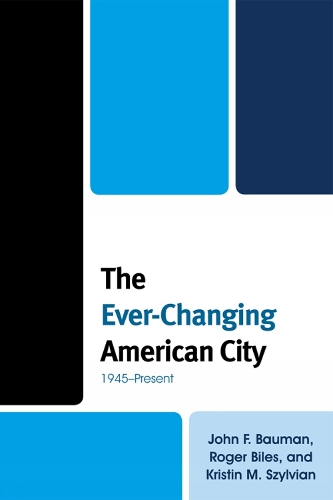
The Ever-Changing American City: 1945Present
(Paperback)
Publishing Details
The Ever-Changing American City: 1945Present
By (Author) John F. Bauman
By (author) Roger Biles
By (author) Kristin M. Szylvian
Bloomsbury Publishing PLC
Rowman & Littlefield Publishers
17th November 2011
United States
Classifications
General
Non Fiction
Urban communities / city life
307.760973
Physical Properties
Paperback
416
Width 155mm, Height 232mm, Spine 12mm
322g
Description
The Ever-Changing American City seeks to help readers understand the marked changes since 1945 in what constitutes a city in the United States and who lives and works in them. The story of the postwar American city is not a simple tale of decline and rebirth. Nor is it a straightforward account of the struggle between the old urban core or central business district and the suburbs on the urban periphery, for both have had their economic ups and downs. In the decades after World War II, the cityscape was altered to better accommodate the automobile, and the city gradually transformed from a place of production to a place of consumption. During the 1980s, city neighborhoods once occupied by migrants from the American South and immigrants from Southern and Eastern Europe began to house newcomers from Asia, Africa, and Central and South America. The economic, environmental, and social issues now facing American cities from Portland, Maine, to Portland, Oregon, will require them to continue the process of remaking or reinventing themselves.
Reviews
Bauman, Biles, and Szylvian are among America's most talented urban historians. They have produced a book that engages, flows, and presents the results of contemporary scholarship in a fashion our students will enjoy and remember.Whether their topic is suburbia, pop music, social media, urban renewal, poverty, wealth, or politics, we never lose sight of larger themes. This book is special. -- Mark H. Rose, Florida Atlantic University
The Ever-Changing American City provides an excellent analysis of how cities changed and are still changing into our present time. The authors, three well-known urban historians, provide an incisive discussion that includes important information on the physical, demographic, political, ecological, and economic urban developments caused by local, national, and worldwide influences. This book is a comprehensive rendering of the urban past and present and should be essential reading for anyone interested in the historic plight of American cities and how the present-day crises evolved. -- Ronald H. Bayor, Georgia Tech
The Ever-Changing American City describes the dramatic transformation of the nations industrial cities to their present postindustrial configuration, which occurred over the course of the second half of the twentieth century. The authors admirably tackle the complicated story of strikingly different federal urban policy strategies from President Johnsons Great Society to President Reagans New Federalism, which significantly shaped, whether successfully or not, cities responses to long-term trends of deindustrialization, suburbanization, immigration, racial integration, globalization, and cultural change. From affordable housing and civil rights to edge cities, gentrified neighborhoods, and city entertainment venues, students will come to understand the important role of federal policy forged under different governmental philosophies for the nature of the cities we inhabit today. -- Edward K. Muller, University of Pittsburgh
Author Bio
John F. Bauman is visiting professor of community planning and development at the Muskie School of Public Service, University of Southern Maine, and professor emeritus of history at California University of Pennsylvania.
Roger Biles is professor of history at Illinois State University.
Kristin M. Szylvian is associate professor of history at St. John's University.
